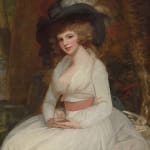

George Romney
Portrait of a Lady, late 18th century
Oil on canvas
52 x 36 ½ in (132.1 x 92.7 cm)
Philip Mould & Co.
To view all current artworks for sale visit philipmould.com Romney began his career in the North of England, but there was insufficient patronage to support a lucrative practice, and he...
To view all current artworks for sale visit philipmould.com
When he returned in 1776 -quite penniless- he established himself once more in London, and very swiftly began to rival the long-established Gainsborough and Reynolds in popularity. His technique encompassed a thorough understanding of form and colour -and at times a greater concern with finish than is apparent in the works of his contemporaries- with a freshness and buoyancy that had an immediate appeal for clients. He has also made himself master of a neo-classical approach to portraiture which embraced modern fashion without compromising a naturalness that English sitters so admired.
Reynolds disliked the younger man intensely, not only for his sudden claim on part of Reynolds' market, but also for fact that he prospered despite total independence from the Royal Academy. It must also be said that Romney's technique avoided the pitfalls of Reynolds's later experiments. The enduring life and freshness of the faces of Romney sitters was a telling contrast with the deathly pallor that, even in the subjects' lifetimes, had begun to emerge from the fading pigments of Reynolds.
Romney returned to Cumbria before his death in 1802. It was suggested that he ended his days in madness, but in fact he fell victim to the depression and introspection which was a facet of his character throughout his life, and which, absent from the effervescent world of his portraiture, finds expression in the dark tortured world of his history paintings and sketches. The late Self-portrait (National Portrait Gallery, London) depicts the painter as he was beginning to surrender to these demons.
George Romney’s vigorous technique can be most easily appreciated in unfinished works such as the present example. Like a great many painters of genius, rather than the plodding journeyman face-painters, Romney’s interest in his works appears often to have become exhausted after the first active phase of execution. Paintings such as the late unfinished Self-portrait (London, National Portrait Gallery) or the remarkable Lady Emma Hamilton as a gypsy (Private Collection formerly with Philip Mould Ltd) show that he delighted in the broad free application of paint to the canvas, and the swift capturing of likeness and character, and is to be forgiven for leaving many works at this exciting early stage before the dictates of convention obliged him to work up the painting to a finished state. In the present example the painter’s technique suggests his engagement with the sitter, and we feel that the sense of connection, the appreciation of the lady’s genial character is genuine and honestly transcribed.
Provenance
Private Collection, USA1
of
36

